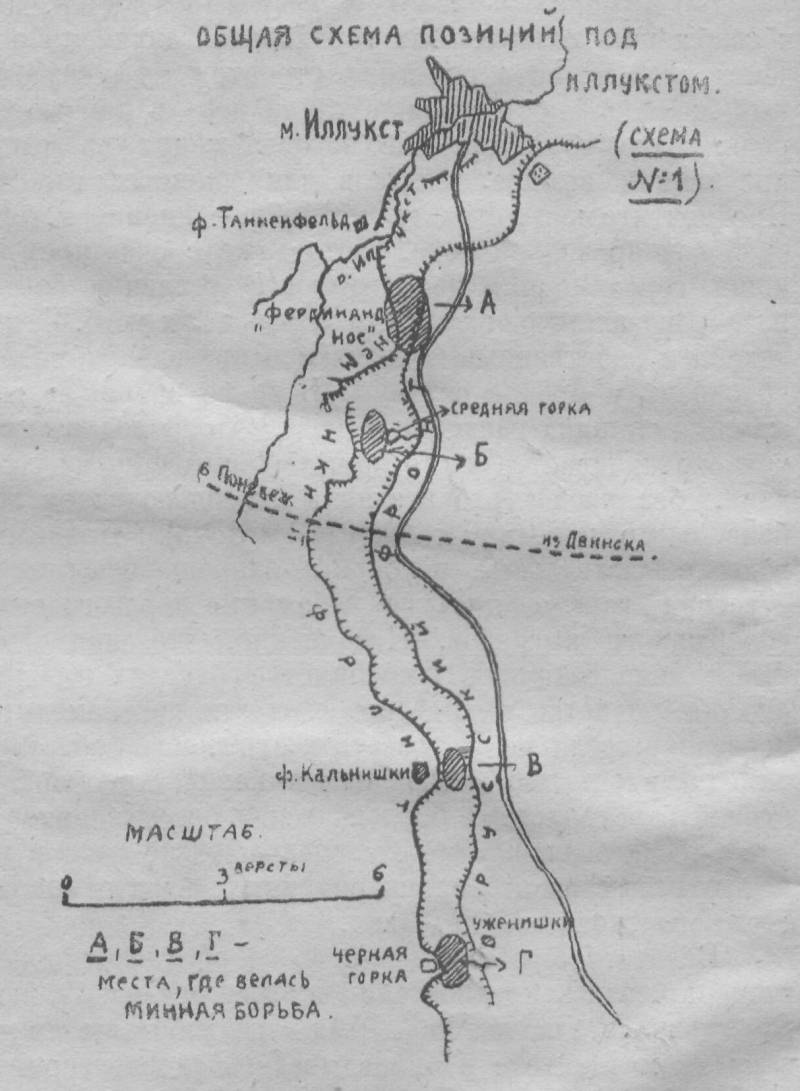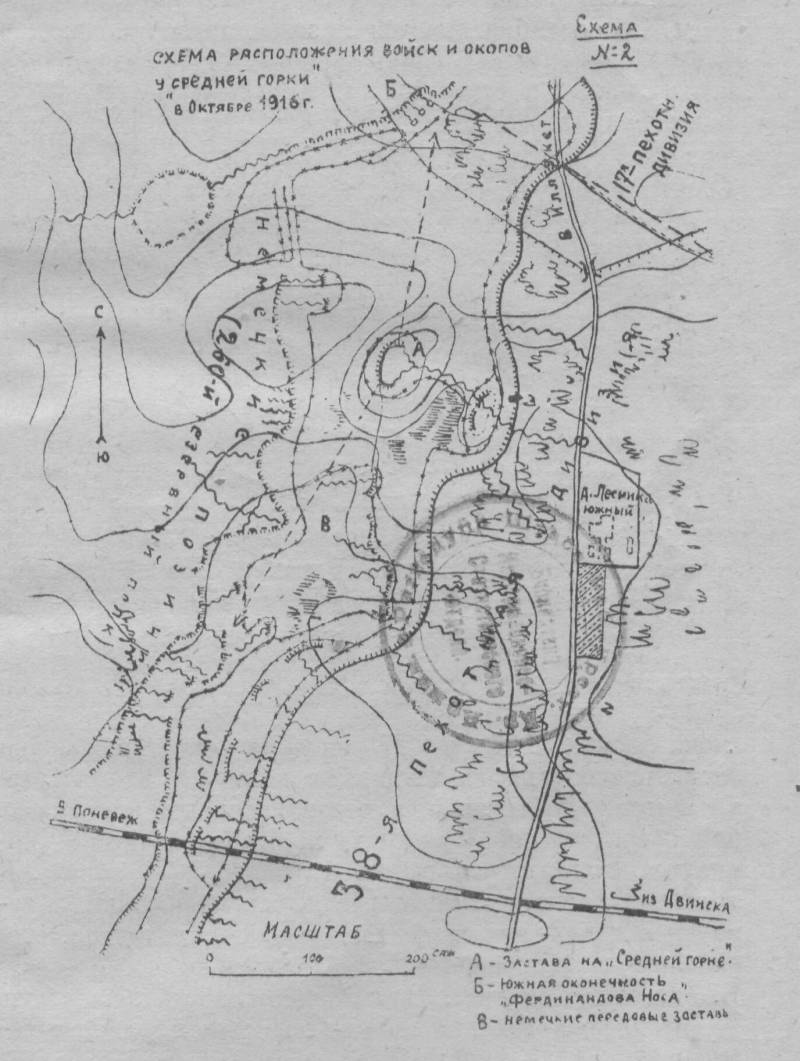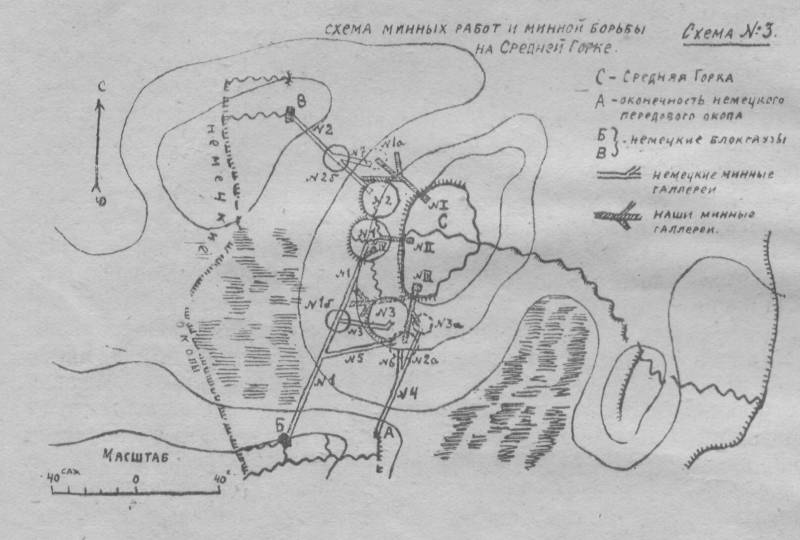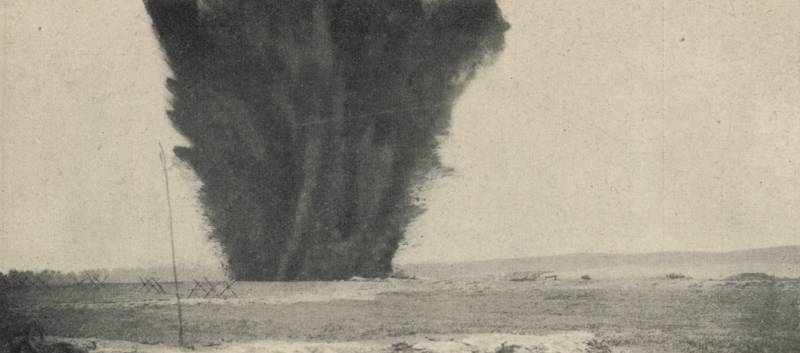Mines near Illuxt
We wrote about its specifics in general (World War One World War) and about the actions of the miners on the Russian front - in the Carpathians (Mine Carpathians). Now I would like to recall another illustrative episode that occurred on another part of the Russian front - on the Northern Front, under Illoukste in 1916.
The mine fight in the context of positional warfare has been widely used in both the French and the Russian fronts. On the Russian front, from the Baltic to the Black Sea, there were up to 40 points, on which mines were carried out on a given scale, in almost all cases ending with a collision with the enemy — that is, mine wrestling.
An interesting episode of a mine warfare took place in the Dvinsk area - in the area of the 38-th Infantry Division of the 19-th Army Corps, not far from the town Illoxt.
On the 12-km front, from places. Illukst to der. Uzhenishki, from November 1915 to the end of 1916, mine work was carried out at four points: at the Tannenfeld farm (a kilometer south-west of places Illoukst), in a section that, in the characteristic direction of the front of the German positions, went into position Russian, received the name "Ferdinand Nose", then slightly south, at the so-called "Middle Hill", still far south (kilometers in 7,5) - in folv. Kalnyshki, finally, in 1,5 km further south - near the village of Uzhenishki, on the so-called “Black Hill”.
1 schema.
Judging by the available information, on the largest scale, mine work was carried out at the Ferdinand Nose section (at the Foln. Tannenfeld), but, unfortunately, the detailed data on these works are not available to the author. But we can briefly describe their purpose, nature and results.
In January, the 1916 g. Units of the 17 Infantry Division took up positions on the east bank of the r. Illuxt The division, on the eve of the March offensive, which was planned to take place in March, was given the task of approaching the enemy at a distance from which the Germans could be attacked. The specifics of the area allowed to implement this task only in areas of places. Illuxt and southeast of folv. Tannenfeld.
In the first section, by the beginning of 1916, the Russians occupied a cemetery on the southeastern outskirts of the town, and further progress was made gradually - by laying a number of parallels with flying sap. In the area of the bridgehead southeast of the folv. Tannenfeld such advancement could be carried out only up to a distance of approximately 100 steps from the enemy - and then had to go throw-over, getting close to the enemy to 30 and even fewer steps.
The trenches of the opponents in this area were very solid and flanked by the Russians, making it difficult to attack - so it was decided to capture enemy trenches with a mine attack. Russian sappers brought a number of mine galleries and sleeves. In mid-February, the galleries were completed, and solid horns of powder and pyroxylin from 5,7 to 16,4 tons were laid at their ends.
These horns, in the number of 14 units, were blown up by February 21 — and a bitter struggle was fought for the craters that were formed. The 6 craters were firmly occupied by the Russians, and in one of the craters the Germans, who suffered great losses, were surrounded in a dilapidated blockhouse by our soldiers. But the main goal was not achieved - the enemy’s trenches were destroyed and were not captured. One of the participants in this episode noted in his notes that the reasons for the failure were the following circumstances: 1) galleries were conducted at very small depths, only 1,5 - 2 meters below the surface of the earth - as a result, they were often destroyed by mortar fire, which delayed the work, and as a result, they did not have time to bring the galleries under the German trenches to the moment designated for the explosion of the forges; 2) lacked the technical means, which, again, slowed down the work; 3) due to the lack of communication between the miners and the infantry.
In the following months, up to 1917, work on the Ferdinand Nose section was conducted on a smaller scale and did not bring any special results.
Somewhat more detailed data is available on the mine-underground struggle that unfolded in September 1916 in 1,5 km south of the above-mentioned section - in the area of Srednyaya Gorka. During this period, the section that ran from the Libauvo-Romenskaya railway to the intersection of the large Illuksta road with the forest road was occupied by the 38 Infantry Division of the 19 Army Corps of the 5 Army.
The “Medium Hill”, which rose to 5 meters above the marshy lowlands, attracted the attention of the corps commander during one of its visits to the position. The order was given: to gain a foothold on this hill. The tactical significance of the hill was that it was possible to flank the southern part of the Ferdinand's Nose and a group of German advanced trenches with rifle and machine-gun fire.
Scheme number 2.
The value of the “Middle Hill” was also appreciated by the Germans, who began to systematically bombard it with artillery and mortar fire and rifle grenades. With the help of the message from the Russian trenches, it was possible to take a slide. A small trench was built on it, initially at the rate of half a hem and then a company. Machine guns were mounted on the flanks of the position.
In September, the trench had a full profile, was equipped with several sub-dugouts, machine-gun nests and connected with the rear of the post, reinforced with sacks of earth and partially adapted to the defense in the south.
According to the participants of the events in question, on the night of 24 or 25 September, a report was received at the division headquarters — north of the hill, at the junction with the 17 division, a knock was periodically heard — allegedly from enemy underground work. Bomb and grenade fire on the hill became more frequent. In the afternoon, the miners of the 2 th company of the 19 th battalion of the sapper battalion organized an audition, finding out that the enemy’s mine work on the Middle Hill was apparently not conducted. It was suggested that they could be heard against Ferdinand’s Nose — although it was difficult to establish the direction and distance of underground work: the Germans, by firing enhanced bomber-grenade firing, masked their underground work.
Thus, the attention of the miners was drawn mainly to the Ferdinand Nose, although listening continued on the Middle Hill. This continued until September 26, when, at 9, the Germans, after 10-minute shelling, blew up their own forge, which formed a funnel about 10 steps in diameter and 60 meters deep in 5 minutes from the Russian trench.
After the explosion, the Germans rushed to occupy the funnel - but the rifle and machine-gun fire were put to flight. The Russian fighters managed to occupy the nearest crater crest, where they dug in the evening. Mine fight ensued.
On the same day, in accordance with the order of the division commander, the commander of the 2 th sapper company, captain Radkevich, began to organize counter-mine operations on Srednaya Gorka. The situation clearly indicated that: 1) the Germans decided to get rid of their Medium Hill disturbing them with a mine attack (making sure that they couldn’t force out the Russian outpost only by fire; they didn’t take the trench by open force, did not dare); 2) to divert attention, they undertook underground work from the “Ferdinand's Nose” - demonstratively working on this section more noisy (on the “Medium Hill” they drowned out the noise of bombing-and-bombing operations).
After the explosion of the German forge, Captain Radkevich, reinforcing the audition, ordered his minerals to lead the 2 mine galleries: one - towards the north-west, branching it to the 3 sleeves, in order to intercept the enemy's underground work, and the other - as an underground message in the direction to the funnel number 1, from which it was supposed to descend again (by means of a mine well) with the withdrawal of counter-mine arms - to listen to and intercept German galleries.
Since September 26, the delivery of mine frames has been organized.
3 schema.
By the morning of September 27, the secret in Funnel No. 1 securely hid behind earthen sacks and steel shields, connecting with an outpost through the underground message passing at a depth of 3 - 4 meters. At this point, the sappers cleared the collapsed end of the German gallery in the funnel and determined that it was going in a direction approximately to the blockhouse B, hidden in the bushes. No traces of work were found in the gallery, but from time to time there came the noise of a pump - apparently pumping out water.
On the night of 27, September, an audition from the northern edge of the funnel No. 1 and the well No. 1 found works by Germans operating against the northern tip of the Russian trench on the slide: from time to time there was noise from the movement of underground carriages.
27 September, at 5 hours 10 minutes, the Germans blew up the second horn - somewhat weaker than the first. The funnel No. 2 was formed, to the north (to the right) of the funnel No. 1, against the northern corner of the trench of the outposts - with a diameter of about 50 steps and a depth of about 4 meters.
The leader of the Russian counter-mine works faced a difficult task - to block the enemy’s access to the enemy’s mine trench under the ground and to take the initiative out of the hands of the enemy. The latter was especially difficult - after all, in the current situation, the Germans, working for at least two weeks, passed 100 - 170-meter distance. Having determined, taking into account the state of the ground and the topographic data of the area, that the Germans can only lead galleries in two directions (from the tip of the trench of gate A and blockhouse B and in the direction from blockhouse C), Captain Radkevich decided to continue to run a counter-mine gallery started from well number 1 - in the direction of the blockhouse B. At the same time, he ordered to start digging a new well number III at the southern tip of our trench - with the withdrawal of a counter-mine gallery with branches in the direction to the tip of the enemy trench A and south-west The intersection of the German gallery number 1, coming from the blockhouse B. Thus, in the southern and north-western directions there should have been a whole counter-mine system.
The audition found that the Germans continued to work in their gallery number 2 and, apparently, are new sleeves number 3 and number 5 from gallery number 1 and sleeve number 6 from gallery number 4. In these directions, the noise was detected as if from the movement of the trolleys, the work of the engine and the gurgling of water. Our work, which was done entirely by hand, continued - to the minerals, who worked continuously in three shifts, workers from the infantry (to 8 people per gallery on each shift) were given to help. The mines were prepared by sappers, and the infantry brought them to the galleries.
On September 30, at 5 hours, the Germans blew up the third horn, which formed the No. 3 funnel against the southern outgoing corner of the Russian trench — the closest ridge in 12 steps from the last parapet. The horn, apparently, was laid quite powerful, since the funnel was a diameter of 60 steps and a depth of about 6 meters. The explosion, however, was incomplete, because later in the funnel more than 300 kg of unexploded "carbonite" in the form of cubes with an edge in an 4 inch was discovered. Probably, the Germans hoped to simultaneously undermine the southern tip of the Russian trench with the help of a powerful forge and fill up Russian counter-mine galleries, wedged between them. But our counter-mine network did not allow them to get close enough to the trench - and the Russian galleries also suffered little from the explosion of the enemy's forge.
Horn blast
Funnel No. 3, like the previous ones, was occupied with Russian secret, and the sappers, despite the enemy fire, began to research it and identify the end of the German gallery - to check its direction and, in accordance with the data, change the direction of work.
By this time, funnels No. 1 and No. 2 had already been connected by a train, the underground passage from well No. II was completed, and a gallery was taken from well No. 4 in funnel No. 1 to the German gallery No. 1 - for listening.
Continued mine work and listening from galleries coming out of wells No. I and No. III showed that the assumptions were correct: the Germans conducted underground works in the direction of the Russian galleries, but declined from the latter, trying to get around them and go directly to the outposts of the outposts.
On the night of 6, the German sleeve number 7 was finally groped, and at the end of the Russian gallery opposite this sleeve, a charge was laid in 655 kg of tola and black powder — it was blown up at 5 in the morning, destroying (No. 1a) German sleeve.
In the afternoon of October 6, another German sleeve was groped, coming out of their gallery number 1. And Russian miners laid camouflage (2 A) of the same amount of explosives - in the tip of the gallery, coming out of the well number III. An explosion that struck the 19 watch destroyed the German sleeves No. 5 and No. 6.
The audition revealed a faint noise in the German galleries No. 1 and No. 2: you could hear the pumping of water, the engine running and the movement of the trolleys. It was found and the conduct of the enemy work in the direction of the German gallery number 4. And the Russian miners laid the third camouflage - the same size as the two previous ones - on the tip of the sleeve, departing from the gallery, which came from well No. III. By October 14, the 9 was finished in October, and in the 14 hours of the 15 minutes, an explosion destroyed the enemy gallery.
Thus, in all the most important areas, the initiative has passed into the hands of Russian miners. The Germans understood this, and around 15 hours of October 10, using two successive powerful underground explosions (camouflage No. 1b and No. 2b) destroyed the nodes of their main galleries No. 1 and No. 2, blocking the Russians from accessing their mine system.
Having failed in the underground struggle, the Germans attempted to take a trench on the Middle Hill by an 2 in November with an infantry attack with powerful artillery support. This attack also failed - once again confirming the importance of the defended point.
The participants in the minefield explained the success in the considered episode by the competent organization of the underground listening service - which made it possible to determine the direction of enemy underground work. And the miners were active - under the guidance of an experienced and energetic commander, Captain Radkevich. Within two weeks, they had opened 4 mine wells and brought out over 250 meters of mine galleries, for which they harvested up to Dutch 3000 frames. In contrast to the mine work on the Ferdinand Nose, a tactical connection was also felt in the actions of the sapper and infantry — which was of paramount importance. At the same time, the supply of the sappers with technical equipment made itself felt — for example, there were no real instruments for listening, and Captain Radkevich had to improvise. The “water stethoscope” was made from the tin flat box, 8 inches wide, 10 inches long and 5 inches high, in a handicraft way. The device was divided by a partition into two unequal parts: in one there was water, and in the other, smaller in volume, a spiral spring, to which the microphone from the field telephone adjoined, connected with wires with an acoustic tube and an element. There were also no pumps, an electrical station for lighting galleries using incandescent bulbs, there were no drills, etc.
It is not known - as in this case, the enemy was supplied with the specified technical means. But in other parts of the huge front, Russian fighters had to capture German and Austrian mine and counter-mine systems, equipped with excellent electric lighting networks, perfect drainage devices, convenient trolleys for land removal, the finest listening devices, mechanical gadgets, and finally special suits. for miners (the latter included helmets and gas masks). The French and the British testify to the same equipment of the German miners on their front. For their own part, the Germans, for understandable reasons, tried to diminish the perfection of supplying their miners with technical means, both over the Russians and the Anglo-French. But in the writings of German authors, we encounter indications that Germans used electric drilling machines, motor fans (operating at a distance of 200 meters), powerful incandescent light bulbs, special drop wells made of reinforced concrete rings or sand), special pumps (for pumping water), etc.
But, as we see, even in the absence of equally powerful technical equipment, Russian miners acted competently, courageously and actively - often leaving the winner in the fight against a dangerous and sophisticated enemy.




Information